A QUICK GUIDE TO CONSTRUCTION AGGREGATES
What are Aggregates?
The term ‘aggregates’ is a broad term for a material that is used for construction.
This includes gravel, sands, crushed stone, etc.
What are they used for?
They are used for a variety of construction purposes, including:
Concrete / Road Construction / Brick Making / Drainage / Bedding / Sub-bases
Capping / Backfill
The different types of aggregate materials
Recycled aggregates are materials typically used in construction work that have been reprocessed as a sustainable, cost-effective alternative to aggregates. The purpose of recycled aggregates is to reduce the impact on the environment – landfills are used less and it helps to improve recycling rates. These are incredibly versatile, and available in a range of shapes, densities and colours:
Granite:
Granite is extremely hard wearing and durable material that is primarily used for concrete and block paving. Its natural beauty and variety of colours make it a popular choice for decorative projects, including driveways, pathways, flowerbeds and landscaping.
Limestone:
Limestone is a sedimentary rock made of calcium carbonate. It is used for a variety of construction purposes such as a building material, a component in the production of concrete, and for the creation of roads. It’s also used to create Lime which can help to neutralise acidic soils.
Sandstone:
Sandstone makes up about 20-25% of all sedimentary rock. It is composed of sand-sized grains, which means it has different levels of resistance to weathering. Although Gritstone, a type of sandstone, is extremely tough. It is commonly used as a building material or in asphalt concrete.
Demolition Waste:
All of the above materials are quarried from the earth and are in limited supply. Aggregates can also be produced by recycling demolition wastes such as brick, hardcore, and concrete. Recycled Aggregates provide a sustainable and cheaper alternative to quarried materials.
How are aggregates produced?
This can depend on the type of aggregate that is being produced, but usually, the material is extracted from reserves in the earth using heavy plant or controlled explosions. This raw material will often then be processed by being feed through a crusher to achieve the desired size. If the material needs to be free of fines it will then be scalped and separated.
Examples of different construction aggregates/materials
Type 1 Sub-base
Type 1 Sub-base or MOT Type 1 as it is commonly known, is an unbound granular material made by crushing rocks to a size between 0-40mm.
If the material is to be used on highway works it must comply with the Specification for Highway Works, Clause 803.


6F2 / 6F5 Capping
An unbound, well-graded aggregate that is produced by crushing rocks to a size of 0-75mm. This variety in particle size makes it strong under compaction.
It is often used to create development platforms where a sub-base along is not viable.
Sands
There are a variety of different construction sands that are produced by crushing materials down to dust, this is often between 0-5mm in particle size.
Types of sand include building sand, grit sand & fill sand, which can be used for: Backfill, Brick Laying, Capping, Ducting, Sub-bases, Rendering, and Screeding.


Pipe Bedding
As the name suggests Pipe Bedding is used as a bedding layer for pipes. It’s produced by screening crushed rock into single sizes, usually between 10mm & 20mm.
The uniform size allows water to pass through easily, making it great for drainage usage.
Clean Stone
Clean stone is a coarse aggregate that has been screened to remove any fines. It is often supplied either at 45mm single size or 75mm single size.
It can be used as a subbase for areas that require good land drainage or as a bedding layer for utilities.


Clay
Also referred to as engineering clay, clay is an impermeable material which means water is unable to pass through it.
It is mainly used to line ponds/water features or landfill cells. Depending on the quality of the clay it is also used by brick manufacturers to produce bricks.
Get in Touch
Fill in your information and one of our team will be in touch to help.


